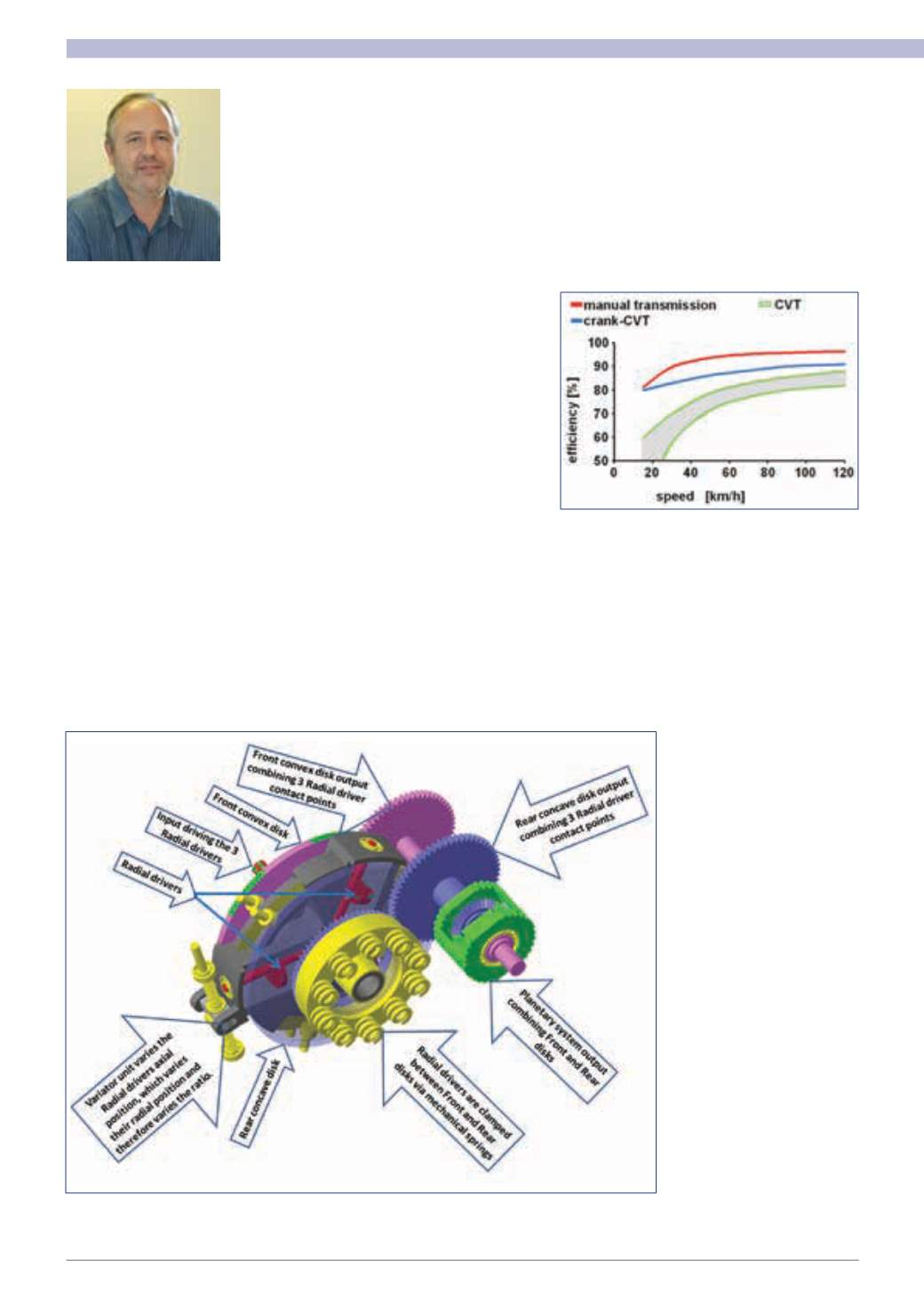

10
¦
MechChem Africa
•
April 2017
V
aribox CVT was set up in 2007 to
develop ‘out of the box’ continuous
variable transmission (CVT) solu-
tions: identifying the shortcomings
in main stream CVT system and addressing
these shortcomings at a fundamental level
by inventing patentable design alternatives.
“ThefirstCVTswere invented in the1960s
in The Netherlands. These were based on us-
ing two variable diameter pulleys connected
by a thick rubber belt. Each pulley consists of
two interconnected conical halves that slide
towards and away fromeachother.When the
cones are apart, the belt runs closer to the
shaft axis andvice versa. By synchronising the
driver and the driven pulley so that the driver
pulley gets larger or smaller while the driven
pulley gets smaller or larger, the speed ratio
can be continuously varied,” begins Naude.
When connected to an engine manage-
ment system, CVTs offer analterative tofluid-
based automatic transmissions or automated
manual transmissions (AMTs), but CVTs are
stepless and do not require individual gears
Varibox CVT Technologies, a SouthAfrican Intellectual Property (IP) company, has recently received
search report feedback from a PCT (Patent Cooperation Treaty) application for its RADIALcvt
design in which all 12 claims have been granted without modification.
MechChem Africa’s
Peter
Middleton talks to Jan Naude of Varibox, the company’s managing director and principle inventor.
“Efficiency losses are usually evaluated at the maximum
power point, which is a bit misleading,” says Naude. “A
100 kW CVT might be 95% efficient when transferring
100 kW, but if only transferring 20 kW, its efficiency is much
less,” he says.
Reference: LuK Symposium 2002: Crank-CVT_de_en.pdf: Figure 11.
Following a PCT patent search application last year, Varibox’s RADIALcvt, received a clean search report in February
2017. All 12 unique claims were granted 100% unmodified.
A revolutionary CVT
is
to be engaged and disengaged.
Fast forwarding to 2016, Naude
saysBoschnowowns the intellectual
property for pulley-basedCVTs that
now use metal bands instead of the
rubber belts. These run using a trac-
tion fluid that separates the metal
band from the metal pulleys. An
alternative is available from LUK,
which uses a metal chain instead of
the belt. “All current CVT systems
available in modern motor vehicles
use one of these two pulley-based
systems,” he tells
MechChem
.
Identifying the shortcomings of
these systems, he says, at any time,
thetwohalvesofeachpulleyarekept
at the required distance apart by an
automatic hydraulic clamping sys-
tem. “The position and the clamping force has
to be very accurately controlled, so hydraulic
pumps and control systems are required to
continuously vary the effective drive- and the
driven-pulley diameters.
Since the pulley radii both vary, the hy-
draulic clamping forces also have to change
depending on the steel belt’s distances from
the rotating shaft axes. This adds a level of
control complexity to the hydraulic system,
raising its costs.
“These CVTs also have two
friction drive systems operating
in series. The power from the
engine comes into the first pul-
ley set and has to be transferred
to the band or chain. This is then
transferred to the driven pulley
at the second friction interface,”
Naude explains.
The use of auxiliary hydraulic
clamping and control systems
and the friction interfaces both
lead to losses. “Losses are usu-
ally evaluated at the maximum
power point, which is a bit mis-
leading,” says Naude. “A 100 kW
CVT might be 95% efficient
when transferring 100 kW, but
if only transferring 20 kW, its ef-
ficiency ismuch less. On average,
across the normal load profile
for a pulley-based CVT, an 85%
transfer efficiency is typical.
Running a hydraulic pump off
the drive absorbs a further 5%
of the output power. So the ac-
cumulated losses can amount to
20% or more,” he says.
















